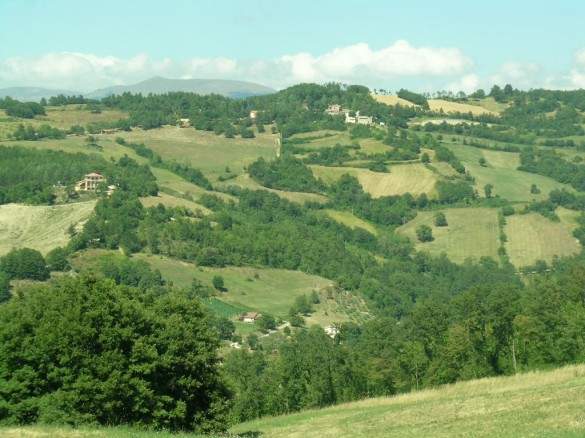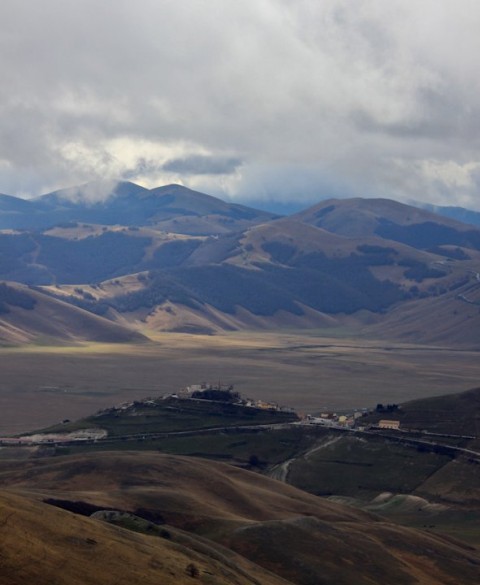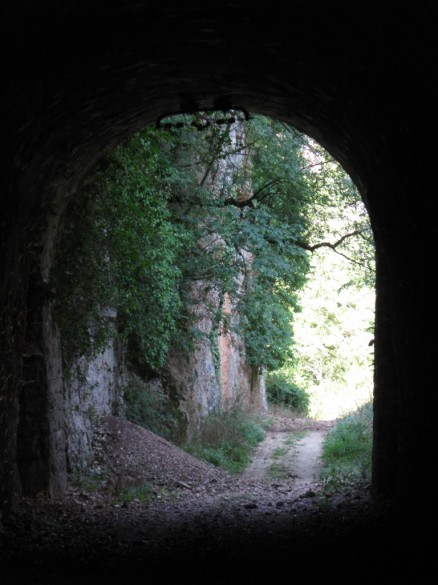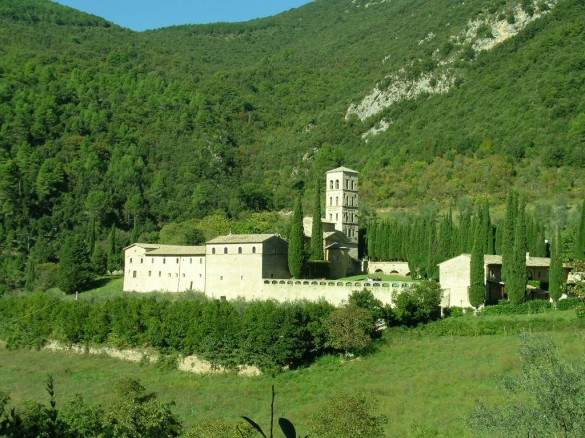If you are an avid walker and keen on exploring the rolling Umbrian countryside on foot, I have good news and bad news. The good news is that even if you get lost, chances are the scenery will be so stunning that you won’t mind that much. The bad news is that it is damned easy to get lost.
Umbria is in many ways a hiker’s paradise, yet paradoxically often not that hiker-friendly. (The same perplexing dichotomy applies to family travel in Umbria, as well. They genuinely love kids here, but no one seems to have highchairs and crayons at hand.) This central Italian region has been late to the game in establishing well marked trails, readily accessible itinerary information, and logistical support for walkers (Chalets? Shuttle service? What do you think this is, Switzerland?!?) which is a shame since the undulating landscape, tiny stone hilltop hamlets, and isolated abbeys and fortresses lend themselves to some memorable hikes. Here are five of my favorites, and if –slash-when you do get lost, remember: It’s the destination, not the journey. No, wait. It’s not the destination, it’s the journey. Whatever. Bring your cell phone, just in case.
Oh, and a quick word to the wise before you head off. Hunting is a popular and widely practiced sport in Umbria, so be aware when hiking in hunting season (September through January) and outside of the regional and national parks, where hunting is prohibited. Anecdotal evidence suggests that a wild boar and a person peeing in the woods look remarkably similar from afar. Umbria is also home to quite a few sheep, and their guard dogs can be aggressive while on the clock–give them a wide berth. Finally, be careful walking through high grass or climbing loose rocks…there are vipers in the area which generally flee at the sound of approaching humans but are none too pleased when accidentally tread upon.
1. The Franciscan Trail

It seems only fitting that one of the most beautiful hikes in Umbria has ties to this region’s most famous citizen, whose iconic image adorns everything in this area from liqueur bottles to t-shirts to cement mixers. Imagine it is late summer in the year 1226 and Francis–not yet a saint, yet deeply loved by his followers during his life–is dying in a tiny hamlet near the village of Nocera Umbra (probably Bagnara, though historical documents are unclear) and wishes to set eyes on his lovely hometown of Assisi one last time.
The town sends a group of emissaries on horseback, who follow a meandering medieval road, slowly weaving their way through twenty kilometers of soft hills dotted with stone farmhouses, parish churches, dove towers, and fortresses to collect Francis for his final journey.You can retrace their steps (as do a group of local horsemen every year in September for the Cavalcata di Satriano, which has been reinacting this historic event since 1923) by following trail number 51 (Use a Kompass or CAI map, which are readily available at bookstores or larger souvenir shops which carry guidebooks in Italy.) from Assisi through the Mount Subasio Natural Park, the wooded hills of the Valtopina, to the medieval stone village of Nocera.
2. Il Lago di Pilato

Ever wonder what happened to Pontius Pilates’ bones? Umbria has them, of course. For sheer heart-stopping beauty, the Sibilline National Park is a winner. Straddling the border between Umbria and Le Marche, this vast area is home to dramatic mountain peaks, picturesque flowering plateaus, and a pretty glacial lake with a dark history. One of the most memorable hikes in this region begins at the oft fotographed (once you see it, you’ll understand why) Piano Grande plateau near the tiny hamlet of Castelluccio. From Capanna Ghezzi (you’ll find it on your CAI Monti Sibillini map), follow trail 202 as it climbs the imposing Mount Vettore to the small Lago di Pilato, nestled at the bottom of the glacial basin at the center of the mountain’s U-shaped crest.
This Ice age lake (home to the tiny prehistoric russet-colored crustacean “Chirocefalo del Marchesoni”, which paddles through the water belly-up and sometimes lends a slightly reddish tinge to the lake) was named for the popular legend which holds that the Roman emporer Titus Flavius Vespasianus captured Pontius Pilate in Jerusalem and brought him back to Rome, where he was summarily executed. His body was put in a rough sack and tossed on a cart pulled by a driver-less team of oxen whose careening path ended at the peak which towers above the lake, where they upset the cart and Pilate’s remains fell into the waters below where the bones are said to still lay in its depths.
3. The Spoleto-Norcia Railway

There is something about industrial archaeology which I find particularly poignant…perhaps because it seems less remote than ancient ruins, or because it recalls an age in which progress was heralded with fervent enthusiasm (which, in these times of great reservation about the benefits of technology and a move towards the simple and basic, seems charmingly naive). I am often drawn to renovated 19th century factories, beautiful art nouveau brass instruments, and abandoned historic railways. The line that ran between the lovely medieval hilltown of Spoleto through the mountains to the remote village of Norcia from 1926 to 1968 has been retrofitted as a trail for hiking or biking through some of the loveliest countryside in Umbria.
From the tiny restored station in Spoleto (now used for railway-related exhibits), the 51 kilometer line passes the now-empty stations in the villages and hamlets of Caprareccia, Sant’Anatolia di Narco-Scheggino, Piedipaterno-Vallo di Nera and Borgo Cerreto-Sellano, passing over dizzying stone bridges and under narrow tunnels along the route. It’s fascinating to imagine the effect a relatively fast and modern transit system must have had at the beginning of the 20th century on these isolated towns, where travel between them had been for centuries—if not millenia—solely by foot or donkey. The trail is significantly less maintained from Sellano to Norcia, but still worth the logistical difficulties for both the views from the hilltops and the silence of the remote countryside. Once you make it to the pretty foodie mecca of Norcia, reward yourself with some of their famed black truffles or excellent charcuterie. You’ve earned it.
4. The Valnerina

Know’st thou the mountain, and its cloudy bridge?
The mule can scarcely find the misty ridge;
In caverns dwells the dragon’s olden brood,
The frowning crag obstructs the raging flood.
Know’st thou it well?
(– J. W. Goethe, Mignon)
The Spoleto-Norcia Railway follows the northern half of the Valnerina, but the wild and rugged scenery in the southern half, where the crystalline Nera river runs under steep mountainsides on which tiny creche-looking stone villages perch precariously, is some of the most dramatic in Umbria. It is an area both stunningly beautiful and foreboding, where the weather can go from sunny skies to black clouds in a matter of minutes, where the isolated hamlets and claustrophobia-inducing sheer rock walls remind you that centuries ago the inhabitants of these inpenetrable peaks held out against conversion to Christianity for long after the rest of the region, where dragons and witches lurked in caves, and where—just to make the area a bit more hostile—each tiny town was locked in perennial warfare with the next one over.
Begin in Ferentillo, after visiting their macabre yet compelling mummy museum, and head along the river to the walled fortress town of Umbriano, completely abandoned since 1950. Though locals hold that the citadel was the first Umbrian town, in truth it lies across the river from the ancient Umbrian territory, in the land once ruled by the Sabines. But it’s a good story, and a fascinating ghost town to explore. From here, cross the valley and the river at Colleponte to visit the Monastery of San Pietro in Valle on the opposite slope. One of the best kept secrets in the region, this former Benedictine abbey—now a four star historical residence—was established in 710 on the site of a Syrian hermitage and was home to monks for the next 800 years. From here climb the craggy slopes of Mounte Solenne, gradually descending through the hamlets of Lorino and the now empty Gabbio back to Ferentillo.
5. Lake Trasimeno
Much like an aging Italian showgirl, this placid lake tucked in the soft rolling hills on the border between Umbria and Tuscany is best admired from afar, and with flattering lighting. Though sun-worshippers flock to its shores in the summer months, bathing in a mud-bottomed lake holds little charm for me. That said, a leisurely walk through the olive groves and meadow-covered slopes overlooking the lake is as refreshing as a dip in its waters. Begin in the fetching resort town of Passignano sul Trasimeno, climbing from the center towards the hamlet of Cerqueto, past the Ristorante La Dimora della Cortesia, to the lovely Mediterranean wood above.
A fabulous view of the lake, her three tiny islets, and the surrounding broom-covered hills awaits you (a perfect picnic spot), and by continuing along this route you hook up with trail CAI 50 taking you back to Passignano. If your curiosity has been piqued, you can take a ferry from the nearby landing to the idyllic (and traffic-free) Isola Maggiore in the middle of the lake, and easily stroll around its entire circumference in less than four hours. Make sure to take a moment at the small chapel on the island’s eastern shore with a statue of Saint Francis, commemorating his 40 days’ fast at this spot. All roads in Italy may lead to Rome, but all trails in Umbria lead inevitably to Francis.
Ready to visit? Look for airfare to Italy and check out the best places to hike in Italy.
Rebecca moved to Italy from Chicago in 1993 and shortly thereafter opened an agriturismo in her husband’s renovated family farmhouse at the foot of Mount Subasio near Assisi, Umbria. She spends her time taking care of guests at Brigolante, blogging about the lovely region she now calls home at Rebecca’s Ruminations, and wondering about what strange winds blew an urban vegetarian to a farm in Umbria.
Top photo by Marco Colzolari, bottom photo by potomo.
